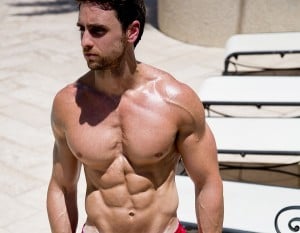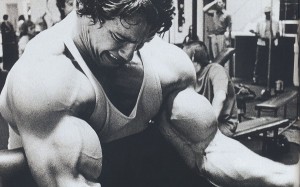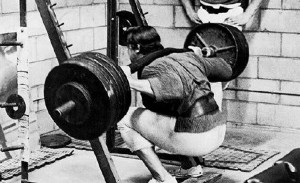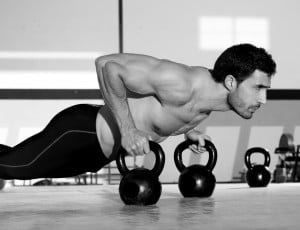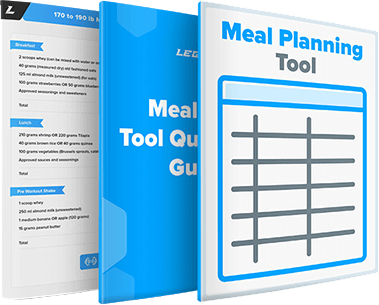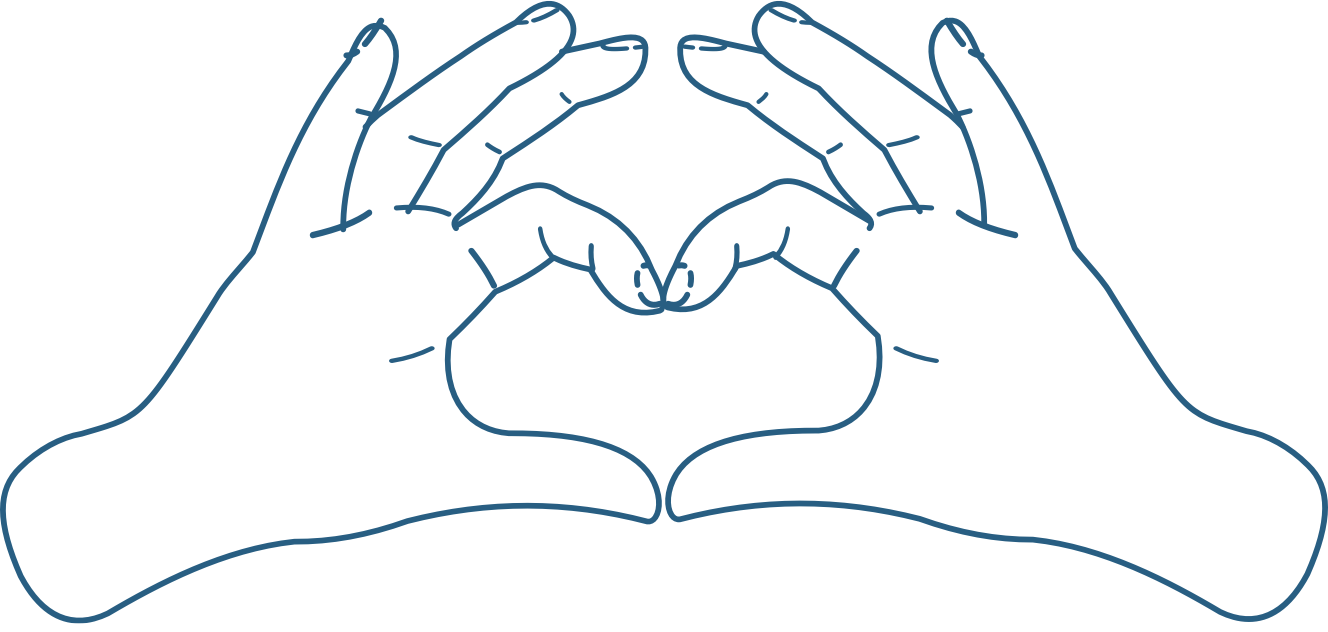An awesome set of thick, diamond-shaped calves is one of those “little” things that really sets a great physique apart from a mediocre one.
Small, under-developed calves, on the other hand, become a glaring weak point as your upper body develops and also give the rest of your legs a bad name. You could be squatting 400 pounds but if your calves aren’t up to snuff, it’ll look like you’ve got chicken legs. (And trust me, I know–I neglected my calves for far too long and am playing catch up now!)
Muscular, strong calves aren’t just for looks either–they help support and stabilize your body during lifts like the Deadlift and Squat, and also during just about every sport you can name. In fact, strong, developed quads and hamstrings can be counterproductive in many sports unless you’ve got calves strong enough to control the force the upper leg can generate as it gets transferred into the ground and redirected.
Weak calves mean shorter jumps, slower running speeds, less stable squats and deadlifts, and a higher risk of knee injury in various sports.
Now, chances are I’m preaching to the choir–if you’re reading this article, you don’t need to be sold on building your calves. You just want to know how to do it, and you’re probably wondering why great calves are so rare. Why do they elude so many weightlifters?
In many cases simple neglect is the problem (like abs, many people forget to train calves or think it’s unnecessary), but as you’ll soon see, there are genetic barriers to work through as well.
So, in this article, we’ll look at the barriers to building big calves as well as a calf routine that will quickly add size and strength to your calves. Let’s first take a quick look at the anatomy of the calf muscles.
Table of Contents
+The Anatomy of the Calves
The calves are made up of two powerful muscles: the gastrocnemius, which is the most externally visible muscle, and the soleus, which is a deep muscle that lies underneath the gastrocnemius.

These two muscles work together to manipulate the foot and ankle joint, as well as flex the leg at the knee joint.
When it comes to just looks, we’re most concerned with the gastrocnemius, but a properly developed soleus almost “props up” the gastrocnemius, making it look more impressive.
Are Calves Workouts Really Necessary?
Some people say that calf training is like ab training–you don’t need to bother with it if you’re doing a lot of Squats and Deadlifts. Well, I disagree.
Unless you’re blessed with great calf genetics, you’re going to have to work your calves quite a bit to maintain proportions with your thighs and arms. And if you’re like me and genetically have zero calves (really…before I started training my calves regularly and correctly, I had nothing no matter how much I squatted and deadlifted), you’re going to have to work them even more.
And while we’re talking genetics, you might be wondering why some people tend to have small calves that basically refuse to grow no matter what they do whereas other people develop bulging calves without hardly trying.
The answer to this “mystery” lies in the composition of the calf muscle fibers themselves.
You see, there are two primary groups of muscle types: Type 1, also known as “slow twitch” fibers, and Type 2, also known as “fast twitch” fibers.
- Type I muscle fibers have the lowest potential for growth and force output, but are very dense with capillaries and rich in mitochondria and myoglobin, which makes them very resistant to fatigue
- Type II fibers have a much higher potential for growth and force output than Type I fibers, but they fatigue very quickly
Research has shown that the muscle fibers of the gastrocnemius–the calf muscle we see and are primarily concerned with developing for aesthetic purposes–can vary in composition from person to person.
One person’s gastrocnemius might be comprised of as much as 60% Type 2 fibers whereas another’s as little as 15%. And thus, the former will find it very easy to add mass to his calves but the latter will find it a slow, frustrating grind (me).
Furthermore, research has also shown that the ratio of Type 1 to Type 2 fibers in various muscles is determined by how we primarily use the muscles. As the calf is mainly used in low-intensity, endurance activities like walking, jogging, biking, and so forth, there’s a greater need for Type 1 than Type 2 fibers.
All that said, it doesn’t mean our genetics ultimately decide whether we are stuck with baby calves or not. With proper training, anyone can build big, muscular calves, but you should just know that it may or may not come quickly depending on the current composition of your calf muscles.
So, let’s get to how to do that by taking a look at the calves workouts that have served me best.
The Ultimate Calves Workouts for the Ultimate Calves
I’ve tried a lot of calf routines and I’ve learned a couple things:
1. Like the abs, the calves seem to recover from workouts quicker than other muscle groups and thus can be trained more intensively.
I’ve yet to find concrete scientific evidence of this, but the anecdotal evidence goes back decades. Arnold even noticed that his calves recovered faster than other muscle groups.
2. The calves seem to respond particularly well to periodized training that includes high-rep work.
Periodized training has you work a muscle group with various rep ranges, and while you can make fantastic gains in your larger muscle groups just working with about 80 to 85% of your 1RM, the calves seem to particularly benefit from the inclusion of higher rep ranges.
There are various theories as to why this is but no definitive answers that I know of. Nevertheless, success leaves clues and this is one you’ll often come across in talking with guys that have built impressive calves and had to actually work for it.
Based on these two points, the calf routine I’m going to recommend works as follows:
- 3 calf workouts per week with at least one day in between each
- 6 sets per workout
- Use a 2-1-2 rep tempo: 2 seconds to full contraction, a slight pause while contracted, 2 seconds to release
- Once you hit the top of your rep range with a given weight, add 10 pounds
Here are the workouts:
Calf Workout A
Rest 2 to 3 minutes in between these sets
Standing Calf Raise
3 sets of 4 to 6 reps
Seated Calf Raise
3 sets of 4 to 6 reps
Calf Workout B
Rest 1 to 2 minutes in between these sets
Leg Press Calf Raise
3 sets of 8 to 10 reps
Donkey Calf Raise (or Leg Press)
3 sets of 8 to 10 reps
If your gym doesn’t have a Donkey Raise machine, you can do Leg Press Calf Raises instead
Calf Workout C
Rest 1 minute in between these sets
Standing Calf Raise
3 sets of 12 to 15 reps
Seated Calf Raise
3 sets of 12 to 15 reps
Simple enough. Personally I do A on Monday, B on Wednesday, and C on Friday.
As with all exercises, form is extremely important in calf training. If you shortchange yourself by reducing the range of motion, you’ll find the workouts far less effective.
The proper form with these calf exercises is simple: At the bottom of a rep, your heels are as low as they’ll go and you feel a deep stretch in your calves; and at the top of a rep, you’re up on your tippy-toes like a ballerina.
Many people simply use too much weight and can’t make it anywhere near as high as they should at the top of their reps and then wonder why their calves never get bigger or stronger. Don’t make the same mistake.
Give this calf routine a go and I think you’ll be pleasantly surprised how quickly your calves grow, even if they’ve been extremely stubborn like mine!
What About Supplements?

I saved this for last because, quite frankly, it’s far less important than proper diet and training.
You see, supplements don’t build great physiques–dedication to proper training and nutrition does.
Unfortunately, the workout supplement industry is plagued by pseudoscience, ridiculous hype, misleading advertising and endorsements, products full of junk ingredients, underdosing key ingredients, and many other shenanigans.
Most supplement companies produce cheap, junk products and try to dazzle you with ridiculous marketing claims, high-profile (and very expensive) endorsements, pseudo-scientific babble, fancy-sounding proprietary blends, and flashy packaging.
So, while workout supplements don’t play a vital role in building muscle and losing fat, and many are a complete waste of money…the right ones can help.
The truth of the matter is there are safe, natural substances that have been scientifically proven to deliver benefits such as increased strength, muscle endurance and growth, fat loss, and more.
As a part of my work, it’s been my job to know what these substances are, and find products with them that I can use myself and recommend to others.
Finding high-quality, effective, and fairly priced products has always been a struggle, though.
That’s why I took matters into my own hands and decided to create my own supplements. And not just another line of “me too” supplements–the exact formulations I myself have always wanted and wished others would create.
I won’t go into a whole spiel here, but if you want to learn more about my supplement line, check this out. (And if you’d like to know exactly what supplements to take to reach your fitness goals, take the Legion Supplement Finder Quiz.)
For the purpose of this article, let’s just quickly review the supplements that are going to help you get the most out of your calves (and other) workouts.
Creatine
Creatine is a substance found naturally in the body and in foods like red meat. It’s perhaps the most researched molecule in the world of sport supplements–the subject of hundreds of studies–and the consensus is very clear:
Supplementation with creatine helps…
You may have heard that creatine is bad for your kidneys, but these claims have been categorically and repeatedly disproven. In healthy subjects, creatine has been shown to have no harmful side effects, in both short- or long-term usage. People with kidney disease are not advised to supplement with creatine, however.
If you have healthy kidneys, I highly recommend that you supplement with creatine. It’s safe, cheap, and effective.
In terms of specific products, I use my own, of course, which is called RECHARGE.
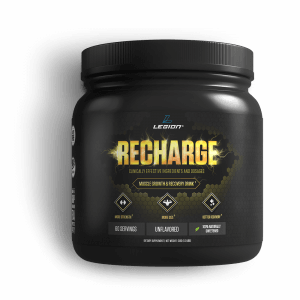
RECHARGE is 100% naturally sweetened and flavored and each serving contains:
- 5 grams of creatine monohydrate
- 2100 milligrams of L-carnitine L-tartrate
- 10.8 milligrams of corosolic acid
This gives you the proven strength, size, and recovery benefits of creatine monohydrate plus the muscle repair and insulin sensitivity benefits of L-carnitine L-tartrate and corosolic acid.
Protein Powder
You don’t need protein supplements to gain muscle, but, considering how much protein you need to eat every day to maximize muscle growth, getting all your protein from whole food can be impractical.
That’s the main reason I created (and use) a whey protein supplement. (There’s also evidence that whey protein is particularly good for your post-workout nutrition.)
WHEY+ is 100% naturally sweetened and flavored whey isolate that is made from milk sourced from small dairy farms in Ireland, which are known for their exceptionally high-quality dairy.
I can confidently say that this is the creamiest, tastiest, healthiest all-natural whey protein powder you can find.
Pre-Workout Drink
There’s no question that a pre-workout supplement can get you fired up to get to work in the gym. There are downsides and potential risks, however.
Many pre-workout drinks are stuffed full of ineffective ingredients and/or minuscule dosages of otherwise good ingredients, making them little more than a few cheap stimulants with some “pixie dust” sprinkled in to make for a pretty label and convincing ad copy.
Many others don’t even have stimulants going for them and are just complete duds.
Others still are downright dangerous, like USPLabs’ popular pre-workout “Jack3d,”which contained a powerful (and now banned) stimulant known as DMAA.
Even worse was the popular pre-workout supplement “Craze,” which contained a chemical similar to methamphetamine.
The reality is it’s very hard to find a pre-workout supplement that’s light on stimulants but heavy on natural, safe, performance-enhancing ingredients like beta-alanine, betaine, and citrulline.
And that’s why I made my own, and I called it PULSE.
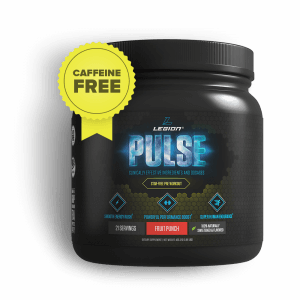
What makes PULSE special, you ask?
- Clinically effective dosages of 5 natural, performance-enhancing ingredients backed by peer-reviewed, well-designed, and well-executed research: caffeine, theanine, citrulline malate, beta-alanine, betaine, and ornithine.
- No proprietary blends.
- No other stimulants than caffeine.
- No artificial sweeteners, flavors, or food dyes.
- No unnecessary fillers, carbohydrate powders, or junk ingredients.
While everyone claims to have the best pre-workout supplement on the market, I can actually back up such claim with real science, and real numbers.
And again, if you feel confused about what supplements you should take to reach your goals, take the Legion Supplement Finder Quiz to learn exactly what supplements are right for you. It’s the best way to ensure you get the most out of your supplement regimen.
Want More Workouts?
The Ultimate Chest Workout
The Ultimate Arms Workout
The Ultimate Back Workout
The Ultimate Shoulder Workout
The Ultimate Abs Workout
The Ultimate Legs Workout
The Ultimate Butt Workout
The Ultimate Forearm Workout
The Ultimate Bodyweight Workout
What do you think of these calves workouts? Have anything else to share? Let me know in the comments below!
Scientific References +
- More S. Global trends in milk quality: Implications for the Irish dairy industry. Ir Vet J. 2009;62(4):5-14. doi:10.1186/2046-0481-62-S4-S5
- Fukushima M, Matsuyama F, Ueda N, et al. Effect of corosolic acid on postchallenge plasma glucose levels. Diabetes Res Clin Pract. 2006;73(2):174-177. doi:10.1016/j.diabres.2006.01.010
- Ho JY, Kraemer WJ, Volek JS, et al. L-Carnitine l-tartrate supplementation favorably affects biochemical markers of recovery from physical exertion in middle-aged men and women. Metabolism. 2010;59(8):1190-1199. doi:10.1016/j.metabol.2009.11.012
- Francaux M, Poortmans JR. Side effects of creatine supplementation in athletes. Int J Sports Physiol Perform. 2006;1(4):311-323. doi:10.1123/ijspp.1.4.311
- Bizzarini E, De Angelis L. Is the use of oral creatine supplementation safe? J Sports Med Phys Fitness. 2004;44(4):411-416. https://www.ncbi.nlm.nih.gov/pubmed/15758854. Accessed December 9, 2019.
- Poortmans JR, Francaux M. Adverse effects of creatine supplementation: Fact or fiction? Sport Med. 2000;30(3):155-170. doi:10.2165/00007256-200030030-00002
- Bassit RA, Pinheiro CHDJ, Vitzel KF, Sproesser AJ, Silveira LR, Curi R. Effect of short-term creatine supplementation on markers of skeletal muscle damage after strenuous contractile activity. Eur J Appl Physiol. 2010;108(5):945-955. doi:10.1007/s00421-009-1305-1
- Eckerson JM, Stout JR, Moore GA, et al. Effect of creatine phosphate supplementation on anaerobic working capacity and body weight after two and six days of loading in men and women. J Strength Cond Res. 2005;19(4):756-763. doi:10.1519/R-16924.1
- Branch JD. Effect of creatine supplementation on body composition and performance: A meta-analysis. Int J Sport Nutr Exerc Metab. 2003;13(2):198-226. doi:10.1123/ijsnem.13.2.198
- Gollnick PD, Sjödin B, Karlsson J, Jansson E, Saltin B. Human soleus muscle: A comparison of fiber composition and enzyme activities with other leg muscles. Pflügers Arch Eur J Physiol. 1974;348(3):247-255. doi:10.1007/BF00587415
- Wojtys EM, Huston LJ, Taylor PD, Bastian SD. Neuromuscular adaptations in isokinetic, isotonic, and agility training programs. Am J Sports Med. 1996;24(2):187-192. doi:10.1177/036354659602400212
